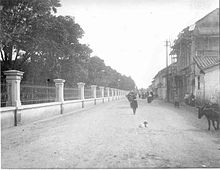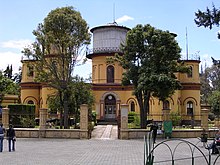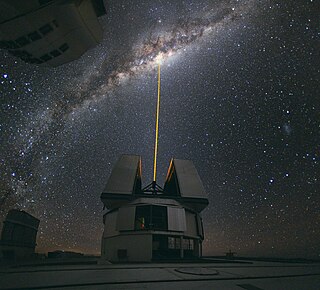
The following outline is provided as an overview and topical guide to space science:
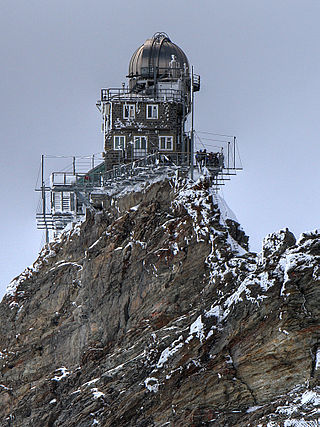
An observatory is a location used for observing terrestrial, marine, or celestial events. Astronomy, climatology/meteorology, geophysics, oceanography and volcanology are examples of disciplines for which observatories have been constructed.

Charles Dillon Perrine was an American astronomer at the Lick Observatory in California (1893-1909) who moved to Cordoba, Argentina to accept the position of Director of the Argentine National Observatory (1909-1936). The Cordoba Observatory under Perrine's direction made the first attempts to prove Einstein's theory of relativity by astronomical observation of the deflection of starlight near the Sun during the solar eclipse of October 10, 1912 in Cristina (Brazil), and the solar eclipse of August 21, 1914 at Feodosia, Crimea, Russian Empire. Rain in 1912 and clouds in 1914 prevented results.

Teide Observatory, IAU code 954, is an astronomical observatory on Mount Teide at 2,390 metres (7,840 ft), located on Tenerife, Spain. It has been operated by the Instituto de Astrofísica de Canarias since its inauguration in 1964. It became one of the first major international observatories, attracting telescopes from different countries around the world because of the good astronomical seeing conditions. Later, the emphasis for optical telescopes shifted more towards Roque de los Muchachos Observatory on La Palma.
Solar physics is the branch of astrophysics that specializes in the study of the Sun. It intersects with many disciplines of pure physics and astrophysics.

The Astronomical Observatory of Modra, also known as Modra Observatory or the Astronomical and Geophysical observatory in Modra, is an astronomical observatory located in Modra, Slovakia. It is owned and operated by the Comenius University in Bratislava. The scientific research at the observatory is led by the Department of Astronomy, Physics of the Earth and Meteorology, Faculty of Mathematics, Physics and Informatics.

The Brera Observatory is an astronomical observatory in the Brera district of Milan, Italy. It was built in the historic Palazzo Brera in 1764 by the Jesuit astronomer Roger Boscovich. Following the suppression of the Jesuits by Clement XIV on 21 July 1773, the palace and the observatory passed to the then rulers of northern Italy, the Austrian Habsburg dynasty.

Astronomical Observatory of Trieste is an astronomical center of studies located in the city of Trieste in northern Italy.

The Llano del Hato National Astronomical Observatory is an astronomical observatory in Venezuela. It is 3600 meters above sea level and is the country's main observatory. It is situated above the village of Llano del Hato in the Venezuelan Andes, not far from Apartaderos which lies about 50 kilometers north-east of Mérida, Mérida State.

The El Leoncito Astronomical Complex is an astronomical observatory in the San Juan Province of Argentina. CASLEO is one of two observatories located within El Leoncito National Park, which is in a part of the country which rarely sees cloud cover. The other facility in the park is the Carlos U. Cesco Astronomical Station of the Félix Aguilar Observatory. CASLEO was established in 1983 by an agreement between National Scientific and Technical Research Council (CONICET) of Argentina, the Ministry of Science, Technology and Innovation (MINCYT) of Argentina, the National University of San Juan (UNSJ), the National University of La Plata (UNLP), and the National University of Córdoba (UNC). The facility was dedicated in 1986 and regular observations began in 1987.
The National Polytechnic School, also known as EPN, is a public university in Quito, Ecuador. The campus, named after José Rubén Orellana, is located in the east-central part of Quito. It occupies an area of 15.2 hectares and has a built area of around 62,000 metres2. Its student body numbers approximately 10,000, of which thirty percent are women. The main campus encompasses ten teaching and research faculties, in addition to four technical and specialized institutes. EPN was founded in 1869 with the aim of becoming the first technical and technological center in the country. Since its beginnings, EPN adopted the polytechnic university model, which stresses laboratory instruction in applied science and engineering. At the campus, there are some libraries with content primarily oriented to engineering and scientific topics.
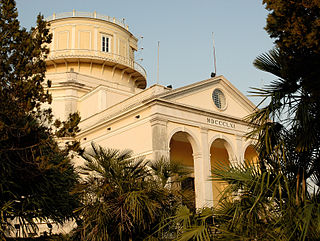
The Lisbon Astronomical Observatory is an astronomical observatory located in Tapada da Ajuda, in the civil parish of Alcântara, municipality of Lisbon. Recognized internationally for its quality of work in the field of positional astronomy, in 1992, it became a dependency of the University of Lisbon, responsible for scientific and historical research, along with media relations.
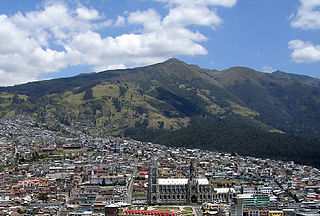
Itchimbía is a hill in Quito, Pichincha Province, Ecuador. It is surrounded to the east by Machángara River, a river that originates in the southern part of the city of Quito. Itchimbía is on the eastern/northeastern border of the center (downtown) of the city of Quito and the southeast border of the northern part.
An astronomical complex or commemorative astronomical complex is a series of man-made structures with an astronomical purpose. It has been used when referring to a group of Megalithic structures that it is claimed show high precision astronomical alignments. For the study of Archaeoastronomy, such complexes of similar structures are required for adequate measurement and calculation to ensure that similar celestial sightlines were intended by the designers. These arrangements have also been known as observational, ceremonial or ritual complexes with importance for the study of prehistoric cultures.

The Quito Astronomical Observatory is a research institute of EPN, the National Polytechnic School in Quito, Ecuador. Its major research fields are astronomy and atmospheric physics.
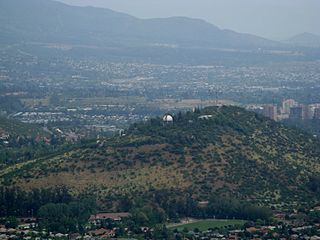
The National Astronomical Observatory of Chile is an astronomical observatory owned and operated by the Department of Astronomy of the University of Chile (UCh). It is located on Cerro Calán, a hill in the commune of Las Condes. The commune is an eastern suburb of Santiago located in Santiago Province of the Santiago Metropolitan Region. OAN was founded in 1852 and became a part of UCh in 1927. The facility on Cerro Calán was completed in 1962.

Pierre Kauffman Radio Observatory, formerly known as the Itapetinga Radio Observatory, is a radio observatory located in the municipality of Atibaia in the state of São Paulo in Brazil. It is located approximately 7.5 km (4.7 mi) south of Atibaia and 40 km (25 mi) north of São Paulo. ROI was founded in 1970 by Universidade Presbiteriana Mackenzie (UPM). Control of the facility was passed to the National Institute for Space Research (INPE) in 1982. Today it is managed jointly by INPE, UPM, University do Vale do Paraíba (Univap), Universidade de São Paulo (USP), and Universidade Federal de Itajubá (UNIFEI). In addition to the telescopes, the observatory has living quarters for visiting scientists. ROI is located inside a small radio quiet zone. It was renamed in 2016 after Pierre Kauffman.
The Instituto de Astronomía Teórica y Experimental (IATE) is a scientific institute funded by the Consejo Nacional de Investigaciones en Científicas y Técnicas (CONICET) and the Universidad Nacional de Córdoba (UNC), located in the city of Córdoba, Argentina, and dedicated to the study of different topics in astronomy. The headquarters of the institute are located at the Observatorio Astronómico de Córdoba.

The Astronomical Observatory of Cantabria (OAC) is a center of the Ministry of the Environment of the Government of Cantabria, Spain, located in the municipality of Valderredible. The OAC is managed by the Environment Research Center (CIMA). Other entities that participate are the University of Cantabria, the Institute of Physics of Cantabria and the Astronomical Association of Cantabria.
Pierre Kaufmann was a French physicist and astronomer. He worked at Mackenzie University, Unicamp, and USP, and founded research into radio astronomy and solar physics in Brazil.
